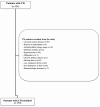Electrocardiographic Frontal QRS-T Angle Is Independently Associated with the Presence of Celiac Disease and Disease Duration
- PMID: 39857071
- PMCID: PMC11763837
- DOI: 10.3390/diagnostics15020187
Electrocardiographic Frontal QRS-T Angle Is Independently Associated with the Presence of Celiac Disease and Disease Duration
Abstract
Background: The impact of Celiac Disease (CD) is not only limited to the intestinal system, but extraintestinal manifestations may also be seen. In this context, cardiac manifestations have recently been the focus of attention. This study aimed to evaluate myocardial repolarization properties in CD patients by assessing the frontal QRS-T Angle (fQRS-T) on electrocardiography (ECG). Methods: A total of 302 patients, including 150 CD patients and 152 control group patients, were included in the study. ECG parameters, including fQRS-T, QRS interval, and QTc interval, were calculated for each patient and compared between the groups. In addition, the relationship of these ECG parameters with disease duration was also analyzed. Results: The median disease duration was 38.5 (16 to 96) months in the CD group. Significantly wider QRS interval (92 (86 to 96) vs. 83 (76.3 to 93), p < 0.001) and fQRS-T (23 (13 to 37) vs. 18 (6.3 to 27), p < 0.001) values were observed in the CD group. Among CD patients, those with longer disease duration (>38.5 months) exhibited significantly wider QRS intervals (94 (88 to 98) vs. 88 (84 to 94), p < 0.001) and frontal QRS-T angles (29 (14 to 47) vs. 16 (10 to 25), p < 0.001) compared to those with shorter disease duration. A positive correlation between the disease duration and fQRS-T was also demonstrated (r = 0.478, p < 0.001). Multivariable logistic regression identified QRS interval (OR: 1.060, 95% CI: 1.032-1.088, p < 0.001) and frontal QRS-T angle (OR: 1.028, 95% CI: 1.013-1.043, p < 0.001) as independent predictors of CD. Additionally, the QRS interval (OR: 1.066, 95% CI: 1.012-1.124, p = 0.016) and frontal QRS-T angle (OR: 1.021, 95% CI: 1.003-1.038, p = 0.021) were significant predictors of longer disease duration. A linear regression analysis confirmed that disease duration was a stronger predictor of frontal QRS-T angle widening (B: 0.389, 95% CI: 0.102-0.677, p < 0.001) compared to age (B: 0.184, 95% CI: 0.123-0.245, p = 0.008). Conclusions: In this study, we demonstrated that chronic inflammation secondary to CD may have negative effects on cardiac repolarization and that this effect is closely related to disease duration.
Keywords: celiac disease; electrocardiography; frontal QRS-T angle.
Conflict of interest statement
The authors declare no conflicts of interest.
Figures



Similar articles
-
Assessment of QRS duration and presence of fragmented QRS in patients with celiac disease.Int J Med Sci. 2024 Jul 16;21(10):1884-1889. doi: 10.7150/ijms.98131. eCollection 2024. Int J Med Sci. 2024. PMID: 39113888 Free PMC article.
-
Comparison of frontal QRS-T angle in patients with schizophrenia and healthy volunteers.J Psychiatr Res. 2022 May;149:76-82. doi: 10.1016/j.jpsychires.2022.02.033. Epub 2022 Mar 2. J Psychiatr Res. 2022. PMID: 35255386
-
Evaluation of frontal QRS-T angle values in electrocardiography in patients with chronic rhinosinusitis.BMC Cardiovasc Disord. 2023 Mar 27;23(1):160. doi: 10.1186/s12872-023-03175-1. BMC Cardiovasc Disord. 2023. PMID: 36973652 Free PMC article.
-
Electrocardiographic frontal QRS-T angle is independently associated with panic disorder.Int J Psychiatry Med. 2024 Mar;59(2):167-181. doi: 10.1177/00912174231184759. Epub 2023 Jun 21. Int J Psychiatry Med. 2024. PMID: 37342881
-
The Effect of Electroconvulsive Therapy on Frontal QRS-T Angle in Psychiatric Patients.Noro Psikiyatr Ars. 2024 May 29;61(2):135-140. doi: 10.29399/npa.28443. eCollection 2024. Noro Psikiyatr Ars. 2024. PMID: 38868850 Free PMC article.
References
LinkOut - more resources
Full Text Sources

